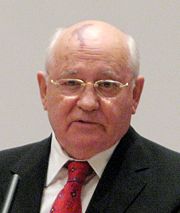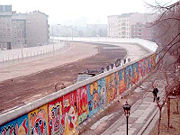The reforms, called “reconstruction” (translation: pérestroïka), would radically change the policies of the USSR but also the dominant global order. They would upset the geopolitical map of Europe and provide for the establishment of democracies on nearly the entire European continent.
The origins and evolution of pérestroïka
At the end of the Brejnev era [1], the socialist bloc rather resembled an old dinosaur, far removed from the contemporary world. The economy was in a deplorable state, independent civil society was largely in exile, and corruption within the state via the Communist Party had become legendary. In addition, the USSR had to devote an enormous portion of its budget to the military.
On the international level, the USSR had lost many allies, because its social model proved to be a decreasingly successful deceit, and the ill-fated invasion of Afghanistan (1979 - 1989). It was therefore necessary to undertake urgent measures, especially in countries where satellite totalitarian regimes were challenged and the USSR was no longer afforded the support of local communist parties.
Gorbachev’s assent to power
The first changes appeared with the rise of Andropov (November 12, 1982) to power and the first anti-corruption trial which wrecked havoc upon the USSR. But he did not remain in power long enough; he died 16 months after his election as head of party. His successor, Chernenko [2] didn’t fare much better. We had to wait for Gorbachev, who came to power in 1985, to see real reforms.
The advent of Gorbachev to power marks the beginning of pérestroïka. His first step upon a meteoric rise to power was the partial liberalization of the press, better known as glasnost. In his speech at the XXVII Congress of the CPSU (Communist Party of the Soviet Union) in 1986, Gorbachev said that “without glasnost, it is not possible to build democracy,” The first free newspapers emerged and some major newspapers such as “Novii Mir (New World),” Argumenti i Fakti “(Arguments and Facts) or” Moskovskie Novosti (Moscow News) changed editors. At the same time, books banned by the Soviet censorship began to appear in stores. Many films which had been censored until this time were finally appearing on the screen. The NIKA (an independent information channel) and ATV (Association of Television Authors) emerged in 1987. New newspapers also cropped up, such as “12th floor” or “Vzgliad” (Viewpoint).
The policy change was also considerable. Under Gorbachev, 140 (ex-)dissidents, victims of Stalinist repression, were honoured and rehabilitated. From exile in Gorky, Sakharov - who vehemently condemned the war in Afghanistan – was released. Several opposition political organizations emerged as a Democratic Union and in 1988 the first anti-communist demonstrations took place.

Gorbachev, considering the difficulty and complexity of the political situation at the time, tried at any price to change the political elite in an effort to ensure pérestroïka. “Policy frameworks” began and brought fresh blood to power. “Without - parties” (those who were not members of the Communist Party) were authorized to occupy important positions in state bodies. In addition, elections are introduced within the party to make elected officials accountable to its voters. Before this time, the party presented a candidate for the post and members could only nod in approval.
The end of Communism
Despite all this progress, the USSR was unable to overcome the economic and social crisis that hit the country in the early 80s. The Soviet system was not adaptable by itself and pérestroïka was therefore doomed from the start. Gorbachev did not have the political capacity to push the desired reforms through. His strategy, in essence, triggered the collapse of the USSR, which was completely unexpected.
Pérestroïka could not change the structure of the Soviet economy, and thus served as an obstacle to reforms. All means of production were under state control, a fact which discouraged the initiative and innovation present in the private sector. In addition, factories managers and corrupt officials wanted at all costs to keep the economic system that afforded them considerable priviledge, especially in a country where the deficit of consumer products was a reality in everyday life. Thus, according to Jacques Rupnik (L’Autre Europe), “the economy was steered as a pyramid of lies in which each plant, each terminal exaggerates its performance to the bodies situated below and above in the hierarchy.”
The political system, like the economy, rested on a foundation of lies. Political leaders from cities and regions fabricated domestic and foreign policy statistics, using propaganda, including the newspaper "Pravda” (Truth). This newspaper was later to become a symbol of Soviet exaggeration of the productivity of the communist state. The Soviet secret services were doing everything to prevent people from having information deemed undesirable; any foreign or independent press was prohibited. In launching his reforms, Gorbachev wanted to reform that which what was not reformable. Pérestroïka and glasnost had made the system fragile, because the lie was no longer there to blind people. Thus, in 1991 a political system that had seemed indestructible - unbeatable, - is eviscerated from the world political map.
What impact upon Europe?
Political systems of the satellite countries of the socialist camp largely resembled that of the USSR. The state was led by a single party, hence the concept of the state-party. Consequently, the leader of the party was also the leader of the state. Fundamental freedoms were never respected and any democratisation reform was duly condemned. Additionally, the intervention of troops provided by the Warsaw Pact in Budapest in 1956 and Prague in 1968 have “vaccinated” all leaders of satellites against any democratic reform.
Pérestroïka was ultimately the determining factor in the fall of the Iron Curtain. The forces it unleashed, such as freedom of speech (glasnost), by Gorbachev inside his country had devoured the communist parties of Eastern Europe. Continuing the policy of rapprochement with the West and democratization of communism in Europe, Gorbachev had condemned the survival of “people’s democracies” in Europe.

That was also the case with the fall of the Berlin Wall and subsequent German reunification. The fall of the Berlin Wall was largely provided for by the green light given by Moscow. Without such approval, it would have been very probably a repetition of the “coup de Prague” of 1968, as the forces of the Warsaw Pact entered the Czechoslovakian capital to put an end to the democratic reforms of Dubcek following the Prague Spring. After the fall of the Berlin Wall on November 9, 1989, the reunification of Germany was inevitable.
The GDR (German Democratic Republic, East Germany) was an artificial creation; it essentially divided a nation in two. The support of the USSR was its sole means of survival. The USSR negotiation of Germany’s reunification resulted on July 16, 1990 with an agreement between Gorbachev and Helmut Kohl. On October 2, 1990, the GDR ceased to exist.
The non-intervention of Warsaw Pact forces during the fall of the Berlin Wall signalled the outbreak of the revolutions that occurred thereafter. Elsewhere in 1989 in Eastern Europe, democratic movements freed from the tutelage of Moscow out-punched Communism. This is the case in Romania with the fall of Ceausescu, Czechoslovakia and Poland with the resignation of the communist government and the start of negotiations between General Jaruzelski and the representatives of Solidarnosc.
The policy of rapprochement between the West promoted by Gorbachev led to the collapse of the Warsaw Pact. Having neither the financial resources nor the political will to save this military alliance, the Soviets proposed in 1988 to repeal the pact against the dissolution of NATO. In December 1988, Gorbachev and Bush declared at a meeting in Malta that the Cold War was over. In 1991, several countries of the socialist bloc announced their exit from the Warsaw Pact, and 1 April 1991 the latter was dissolved. In December the Soviet Union would disappear, taking the socialist camp with it. The broad-sweeping effects of pérestroïka were complete.
The European dream
Immediately after the fall of communism in Europe, former satellites of the Soviet Union clearly chose to join the unified European family and NATO. Chronologically, in the first half of 90 years, almost all the countries of Central and Eastern Europe (CEE) have submitted their applications to join the European Union and NATO. For these countries, membership in these structures is first and foremost a political symbol, because they want to guarantee their freedom and sovereignty.
European integration also means the return of these countries into the European mainstream as equal partners and not merely as “little brothers”, as was the case with the USSR. Long oppressed by a regime imposed from outside, these countries can finally defend their interests in the democratic framework that the European Union offers.
Without pérestroïka, the world today would not be the same. It is mainly through this process that democratization has been set up in the Central and Eastern Europe and that Europe is no longer divided in two.


1. On 7 May 2008 at 12:02, by Gabriella Replying to: The Fall of the Soviet Union and Reunification of Europe
Replying to: The Fall of the Soviet Union and Reunification of Europe
Great article, I think it is really useful base for discussion. A few things plague me as I read the article. I wonder where the article would take the discussion if it didn’t just end at the fall of the Soviet Union, and instead provided a narrative of the evolution of democracy in former Soviet Republics since that time.
Unfortunately, despite the work of perestroika and glasnost in bringing down the formal reign of communism in Central and Eastern Europe (CEE), the problem of political patronage is a legacy that persists in these nations. Simply by virtue of the fact that communist party bosses and infrastructure (phone lines, party headquarter offices, local/regional staffs) were well-established, they continue to be the only political parties with any sort of capacity for grassroots campaigning. As a result, during the first elections in many of these newly-freed countries, the socialist parties (populated by members of the former ruling communist parties) captured the vote in most of the elections. And, from what I have experienced in working in former Soviet republics, these parties that wield so much power run the nations very much as they were run before the fall of the Iron Curtain.
So the question I would pose to other readers is this: what effect has the fall of the USSR really had upon the freedom and evolution of democratic political systems in Central and Eastern Europe? Has there been any at all?
2. On 8 May 2008 at 00:22, by ? Replying to: The Fall of the Soviet Union and Reunification of Europe
Replying to: The Fall of the Soviet Union and Reunification of Europe
Great article, I think it is really useful base for discussion. A few things plague me as I read the article. I wonder where the article would take the discussion if it didn’t just end at the fall of the Soviet Union, and instead provided a narrative of the evolution of democracy in former Soviet Republics since that time.
I agree that it would be better not to stop with the end of the Soviet era, but also to talk about the evolution of these countries during the 90s. I saw this evolution from inside and would be glad to share my experience with those who didn’t. The problem is technical: few people read long articles, and I think this was already too long. But promise, I will do my best to convience my boss to allow me to publish an article on CEE.
3. On 1 June 2009 at 16:54, by Ali Replying to: The Fall of the Soviet Union and Reunification of Europe
Replying to: The Fall of the Soviet Union and Reunification of Europe
this helped me and a class mate get some of what we needed for our research. thank you :)
4. On 23 November 2010 at 05:12, by Kathleen Replying to: The Fall of the Soviet Union and Reunification of Europe
Replying to: The Fall of the Soviet Union and Reunification of Europe
so no continuation of the post-Soviet Union fall?
Follow the comments: |
|
